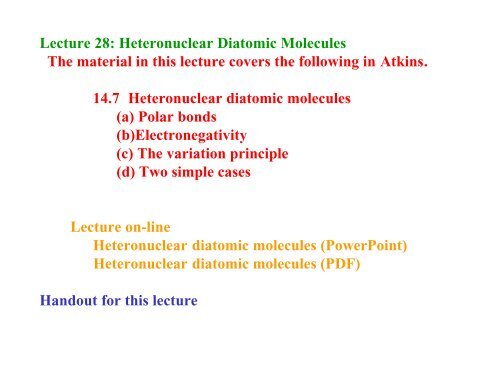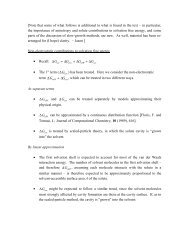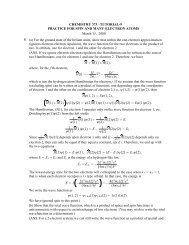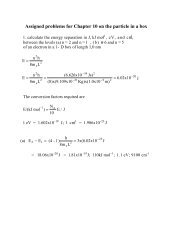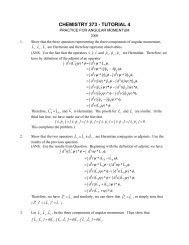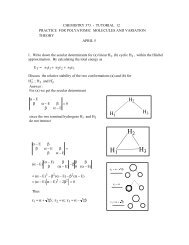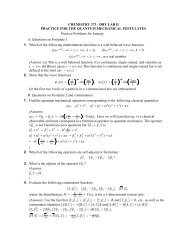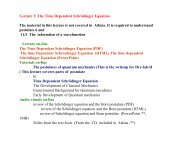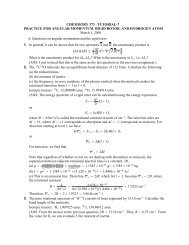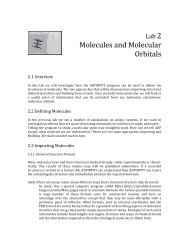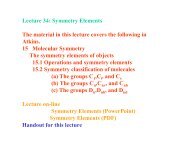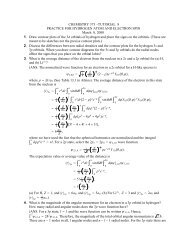Lecture 28: Heteronuclear Diatomic Molecules The material ... - Cobalt
Lecture 28: Heteronuclear Diatomic Molecules The material ... - Cobalt
Lecture 28: Heteronuclear Diatomic Molecules The material ... - Cobalt
Create successful ePaper yourself
Turn your PDF publications into a flip-book with our unique Google optimized e-Paper software.
<strong>Lecture</strong> <strong>28</strong>: <strong>Heteronuclear</strong> <strong>Diatomic</strong> <strong>Molecules</strong><strong>The</strong> <strong>material</strong> in this lecture covers the following in Atkins.14.7 <strong>Heteronuclear</strong> diatomic molecules(a) Polar bonds(b)Electronegativity(c) <strong>The</strong> variation principle(d) Two simple cases<strong>Lecture</strong> on-line<strong>Heteronuclear</strong> diatomic molecules (PowerPoint)<strong>Heteronuclear</strong> diatomic molecules (PDF)Handout for this lecture
<strong>Heteronuclear</strong> diatomic moleculesA heteronuclear diatomic molecule is a diatomicmolecule formed from atoms of twodifferent elementsCO HCl<strong>The</strong> electron distribution in a covalentbond between the atoms is not evenly sharedBecause it is energetically favorable for the electron pair tobe closer to one atom than the other<strong>The</strong> imbalance results in a polar covalent bondin which the electron pair is hared unequally by theatoms<strong>The</strong> bond in HF, for instance, is polar , with the electronpair closer to F.+ δ −δH−FHF
<strong>Heteronuclear</strong> diatomic moleculesIn homonucleardiatomics theatomic orbitalsfrom the two nucleicontribute equallyto the molecularorbitals :1 σ g of H2: 1s+ 11 =s21 ( + S)σ gA BPolar BondIn heteronuclear diatomicsthe atomic orbitals from thetwo nuclei do not contributeequally to the molecularorbitals :1 σ of HAu :=C 1s + C 6s21 ( + S)H H Au Auσ g 2of F :1σg=2p+ 2pσA21 ( + S)σBσ of FI : =CF2pσ+ CI5p21 ( + S)σ2p2π u of N 2 : π 1 π A+ pu =21 ( + S)πBπ of NP : =C 2p + C 3pN πN P πP21 ( + S)
<strong>Heteronuclear</strong> diatomicmolecules<strong>The</strong> ability of an element to attractelectrons is a measure of its :ElectronegativityElectronegativityElectronegativity according to Pauling :χ A = Electronegativity of Aχ B = Electronegativity of BχA − χB| =0.102 × { D(A - B) - 1 2 D(A - A) - 1 2D(B - B)AA bond energyAB bond energyBB bond energy
<strong>Heteronuclear</strong> diatomicmoleculesElectronegativityElectronegativity according to Mulliken :χ A = Electronegativity of A1χ A = IA+ Eea2 ( )Electron affinity of ALarg e value indicatesthat element is a goodelectron acceptorIonization potential of ALarg e value indicatesthat electron is difficultto remove poor electron donor
<strong>Heteronuclear</strong> diatomic moleculesElectronegativity
<strong>Heteronuclear</strong> diatomic molecules Linear variationWe have for the total energyof the trial wavefunctionψ =C ψ +C ψE =AA*B∫ ψ Hψdv*∫ ψψdvBThis energy is optimal ifδEδE= 0 and = 0δCδCAB*∫ ψψdv=∫ ( C ψ + C ψ )( C ψ + C ψ ) dvA A B B A A B B2 2 2 2A A B B A B A B= ∫ ( C ψ + C ψ + 2C C ψ ψ ) dv2 2 2 2A A B B= C ∫ ( ψ dv + C ∫ ψ dvWe now express theenergy in terms of thecoefficients C A and CB+ 2CACB∫ψAψBdv11 Overlap S2 2A B A B= C + C + 2C C S
<strong>Heteronuclear</strong> diatomic molecules Linear variation theoryE =*∫ ψ Hψdvψψ*∫ dvψ*∫ H ψ = C2α + C2α + 2 C C βA A B B A B∫ ψψ* = C2+ C2+ 2C C SA B A BEnergy of electron in orbital ψ A : Always negativeKinetic energy + attraction energy stabilizingfrom both nuclei + repulsion fromall other electronsEnergy of electron in orbital ψ B :Kinetic energy + attraction energyfrom both nuclei+ repulsion fromall other electronsAlways negativestabilizing
<strong>Heteronuclear</strong> diatomic molecules Linear variation theoryE =*∫ ψ Hψdv*∫ ψψdvψ*∫ H ψ = C2α + C2α + 2 C C βA A B B A B∫ ψψ* = C2+ C2+ 2C C SA B A BOverlap between ψ andAψBResonance integral βrepresents energy of overlapdensity S
<strong>Heteronuclear</strong> diatomic molecules Linear variation theoryEC ( A,C ) =B*∫ ψ Hψdv*∫ ψψdvψ*∫ H ψ = C2α + C2α + 2 C C βA A B B A B∫ ψψ* = C2+ C2+ 2C C SA B A Bhus2 2A B A B A B2AαA + C2BαB + 2CACBβEC ( , C )[ C + C + 2C C S]=This energy is optimal ifδEδE= 0 and = 0δCδCAB
<strong>Heteronuclear</strong> diatomic molecules Linear variation theoryThus2 2A B A B A B2 2A A B B A BEC ( , C )[ C + C + 2C C S]=C α + C α + 2C C βWe shall now differentiate respect to Cand make use of that for the optimal C A AdE( CA, CB)/ dCA= ohusodE ( CA, CB) [ C2C C C S E C C SdC A+2B+ 2 A B ] + [ 2A+ 2 B ]A2Cα + 2CA ABr :( α − E ) C + ( β− ES)C = 0βA A B
<strong>Heteronuclear</strong> diatomic molecules Linear variation theoryhus2 2A B A B A B2AαA + C2BαB + 2CACBβEC ( , C )[ C + C + 2C C S]=We shall now differentiate respect to Cand make use of that for the optimal C B BdE( CA, CB)/ dCB= ohusodE ( CA, CB) [ C2C C C S E C C SdC A+2B+ 2 A B ] + [ 2B+ 2 A ]B2Cα + 2CB BAr :( α − E ) C + ( β− ES)C = 0βB B A
<strong>Heteronuclear</strong> diatomic molecules Linear variation theoryWe have derived :Our secular equation( αA − E ) CA + ( β− ES)CB= 0 reads( β− ES) CA + ( αB − E ) CB= 0This is a homogeneous αA-E β-ESlinear equation in theβ- ES αB- E = 0unknown C A and CBThis gives us aquadratic equation inHomogeneous eq :E from which we canA 11 x + A12y= 0determine the two rootsA21x + A22y= 0E + and E-Has only solutions ifthe secular determinants : Here E + corresponds toAA 11 A021 A 12the orbital of lower energy= and E - to the orbital of higher22 energy
<strong>Heteronuclear</strong> diatomic molecules Linear variation theoryA substitution of E = E intothe secular equation +( αA − E ) CA + ( β− ES)CB= 0( β− ES) C + ( α − E ) C = 0A B Baffords the coefficientsC+and CAB +We thus obtain theorbitalψ = C+ ψ + C+ ψ+withA A B Benergy E+A substitution of E = E intothe secular equation -( αA − E) CA + ( β− ES)CB= 0( β− ES) C + ( α − E)C = 0A B Baffords the coefficientsC-and CAWe thus obtain theorbitalψ = C−ψ + C−ψ-withB -A A B Benergy E-
<strong>Heteronuclear</strong> diatomic molecules Linear variation theory− −A A B Bψ- = C ψ + C ψE −This is an out - of-phase anti - bondingorbital withthe largestcontribution from ψof highest energyBα BE +α AA + A B + Bψ+ = C ψ + C ψThis is an in - phasebonding orbital withthe largest contributionfrom ψ A of lowest energy
Ε −<strong>Heteronuclear</strong>diatomic moleculesEα B− =αB− β1−SLinear variation theory<strong>The</strong> solutions| α1. A B orA − αα αB |≈
diatomic molecules<strong>Heteronuclear</strong>α BΕ −EαΕ A+− =αBE+ = α +ALinear variation theory<strong>The</strong> solutions| β |2. αA
diatomic molecules<strong>Heteronuclear</strong>α BΕ −ψ− =− ψ sinζ + ψ cosζBLinear variation theory<strong>The</strong> general solution1 2 | β |ζ = arctan2 α − αABAE− =αA−cotζΕ +α AE+ = α + βcotζBα B −α Aψ+ = ψ cosζ+ψ sinζAB
<strong>Heteronuclear</strong> diatomic molecules Linear variation theoryMolecular orbitals og HF
Molecular Orbital <strong>The</strong>ory <strong>Diatomic</strong>s Term symbolsMolecule Configuration Term symbolHD +( 1σ)12 Σ+Spin multiplicityL Tz : 0 1 2Σ Π ∆2S T + 1SYM( L z )Reflection
Molecular Orbital <strong>The</strong>ory <strong>Diatomic</strong>s Term symbolsMolecule Configuration Term symbolHD( 1σ )Σ +2 1HD − ( 1σ) ( 2σ* )2 Σ+2s−3s4σ *He He ( 1σ) 2( 2σ*)2Σ +2 32s+3s3σLiNa ( 1σ) 2( 2σ*) 2( 3σ)2Σ + s−1s2σ *BeMg ( 1σ) ( 2σ*) ( 3σ) ( 4σ*)Σ + s+1sσSpin multiplicity2S T + 1ReflectionL Tz : 0 1 2SYM( L z )Σ Π ∆2 2 2 2
Molecular Orbital <strong>The</strong>ory <strong>Diatomic</strong>s Term symbolsMolecule ConfigurationBAl ( 1π)CSi ( 1π)421 4NP + ( 5σ) ( 1π)2 4NP ( 5σ) ( 1π)Term symbol3 Σ− 1 ∆+ 1 Σ+1 Σ+2 Σ+1 Σ+5σ1πSpin multiplicityL Tz : 0 1 2Σ Π ∆2S T + 1SYM( L z )Reflection
Molecular Orbital <strong>The</strong>ory <strong>Diatomic</strong>s Term symbolsMolecule Configuration2 4 1NO ( 5σ) ( 1π) ( 2π*)2 4 2SO ( 5σ) ( 1π) ( 2π)Term symbol2 Π− 2 Π+3 Σ− ∆ + Σ −6σ *2πFCl ( 5σ) 2( 1π) 4( 2π)4 Σ −πSpin multiplicityL Tz : 0 1 2Σ Π ∆2S T + 1SYM( L z )5σReflection
<strong>Heteronuclear</strong>diatomic moleculesMetal - main - groupdiatomics2σ2π x2π yδ 1 δ 2Main groupMetal1π x1σ1π y
<strong>Heteronuclear</strong>diatomic molecules1π xg1σ u1π ygMetal - Metaldiatomics1δ u11δ u21δ g11δ g21π xu1π yu1σ g
What you should learn from this lecture1. You should be able to construct inqualitative terms the compositionsand energies of molecular orbitalsfor heteronuclear diatomicmolecules2.You should be able to account forhow the coefficients changesin ψ = C+ψ + C+ψ and ψ = C+ψ + C+ψ+ A A B B + A A B Bchangesas A becomes more electronegative than B3. You should know qualitatively howE + and E - behaves when A and B havethe same electronegativity and whenA is much more electronegative than B
What you should learn from this lecture4. You should be able to figure out theelectron configuration for maingroupdiatomics as well as the term symbol(in simple cases)5. It would be really cool if you alsocould account for the bonding indiatomics containing transitionmetals. But it is not required6.You are required tobe able to derive the equations( αA − E) CA + ( β− ES)CB= 0( β− ES) C + ( α − E)C = 0A B BHowever you will not be askedto solve for E or CAand CBinthe general case


